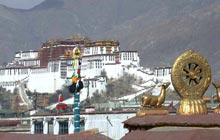
 According to ancient mythology the Yarlung valley – not Lhasa – is the homeland of the Tibetan people. The first Tibetan king stepped off a heavenly ladder onto earth not in Lhasa, but here. The Yarlung valley was also the kingly seat of the first Tibetan kings as well as their burial site. This being the case, why is Tibet's capital at Lhasa rather than in the Yarlung valley?
According to ancient mythology the Yarlung valley – not Lhasa – is the homeland of the Tibetan people. The first Tibetan king stepped off a heavenly ladder onto earth not in Lhasa, but here. The Yarlung valley was also the kingly seat of the first Tibetan kings as well as their burial site. This being the case, why is Tibet's capital at Lhasa rather than in the Yarlung valley?
As with many aspects of Tibet's culture, the answer lies in her religious life. For Tibet's original Buddhist temple, dating from the seventh century, was Lhasa's Jokhang Temple , still found today pulsating at the heart of the Old Quarter. This institution, contemporaneous with the first Potala Palace , heralds Buddhism's first insemination and dissemination in a flourishing Tibetan empire stretching from western China to Nepal, Bhutan and northern India. Though its political fortunes would wax and wane, Lhasa – "the place of the Gods" – would forever thus be associated with the birth of Tibetan Buddhism . It is this birthright that would maintain Lhasa's prominence through subsequent centuries of bitter regional and religious conflict.
So it was that in the fifteenth century the ascendant Gelug monastic sect , leading a puritanical Buddhist revival in Tibet, established its three stronghold monasteries, Ganden , Drepung & Sera , in the vicinity of Lhasa. The scholarly achievements and political savvy of this sect eventually pushed Lhasa once more to center stage. Two centuries later, under the leadership of the new paramount leader of Tibet, the Great Fifth Dalai Lama , Lhasa was instituted the religious and political capital of Tibet. In 1645 the Potala Palace was re-constructed on Red Hill and the Jokhang Temple greatly expanded. Although some wooden carvings and door lintels of the Jokhang Temple date to the seventh century, the oldest of Lhasa's extant buildings, such as amidst the Potala Palace, the Jokhang and some of the monasteries and properties in the Old Quarter date to this second flowering in Lhasa's history.
The Potala Palace, uniting the political and religious roles of the Dalai Lama, neatly symbolizes the symbiotic relationship of Lhasa's religious and secular roles. This inter-dependent mapping is also seen in the routes of the city's kora or pilgrimage routes. The innermost pilgrimage route or Nangkhor is a circuit along the inside perimeter of the Jokhang Temple. The Barkhor , the best known, follows the circumference of the Jokhang Temple past other monasteries, temples and incense burners of the Old Quarter. And the last, the Lingkhor , circumambulates the city's former outer limits.
Although the Yarlung valley is indeed the mythological and historical root of the Tibetan nation, the primacy of Buddhism within the fabric of Tibetan culture has ensured that Lhasa supersedes it as the spiritual and political capital of Tibet.